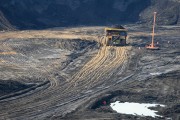Recent oilsands pipeline proposals — most notably Northern Gateway and Keystone XL — have become flashpoints in the public debate about energy development and its environmental impacts. In light of that ongoing debate, we expect that the Energy East proposal will receive similar scrutiny from Canadians.
To help inform the debate over Energy East, the Pembina Institute has published a new report about the potential climate impacts associated with the proposed pipeline. Our research shows that producing the crude required to fill the pipeline would significantly increase Canada’s greenhouse gas (GHG) emissions and make it even more difficult to meet our climate targets.
Energy East: unlocking new emissions
In August 2013, TransCanada announced its intention to build a $12-billion pipeline and export terminal project called Energy East. The proposed route would run from Hardisty, Alberta, to Saint John, New Brunswick. The pipeline could transport up to 1.1 million barrels per day of crude oil, from both oilsands and conventional production sources.
If approved, Energy East would increase the capacity of the pipeline network that carries crude out of western Canada by one-third, providing companies with far more predictable access to markets. Crucially, Energy East could also carry oilsands to tidewater, where it could be exported on tankers to wherever it fetches the best price. That includes the fast-growing economies of countries like India and China, which are becoming a priority for oilsands producers.
By opening up affordable access to these markets, Energy East could make the economic case for expanding oilsands production more compelling, spurring new production and the associated GHG emissions.
Unpacking the numbers
The GHG emissions associated with filling a pipeline depend on the type of crude it transports. TransCanada has said that Energy East would carry a mix of crudes that include diluted bitumen, conventional oil and synthetic crude oil (oilsands bitumen upgraded to a consistency where it can flow in pipelines). However, TransCanada has yet to publicly estimate the proportion of each product the pipeline would transport.
To assess the proposal’s potential emissions impact, we modelled a range of plausible scenarios for Energy East’s contents. These scenarios are outlined in the table below.

Percentage of diluted bitumen, SCO and conventional crude approximated for each GHG emissions scenario. Source: Pembina Institute.
A full explanation of the parameters we used can be found in the report. Our assessment calculates the emissions that result from extracting and processing bitumen and conventional crudes to be shipped using the pipeline. Those calculations include emissions from land use changes, construction, flaring, generating electricity and several other factors.
We assumed that Energy East would operate at 85 per cent of its 1.1 million-barrels-per-day capacity, which falls in the range suggested by previous analyses and reports. Next, we modelled the various mixtures of crude likely to fill the pipeline based on recent production estimates generated by the Alberta Energy Regulator. Finally, we used the appropriate emissions factors to determine the GHG footprint from the production and processing of these crudes.
Our analysis suggests that filling the Energy East pipeline would generate up to 32 million tonnes of GHG emissions a year in Canada.
The table below equates those totals to the number of passenger vehicles required to produce the same emissions.

Upstream GHG emission impact of the Energy East pipeline proposal. Vehicle estimates based on data from Environment Canada.
For an individual piece of infrastructure, that’s a very significant impact. In fact, it’s greater than the current emissions of five separate provinces:

Greenhouse gas emissions associated with Energy East compared to those of selected provinces. Data source: Environment Canada.
Modernizing the review process
In light of our analysis, the Pembina Institute recommends that any regulatory review of the Energy East proposal should include an evaluation of its potential upstream impacts. That means looking not only at the impact of the pipeline itself, but also at the environmental consequences of producing the crude that would flow through it.
Regulators and governments will likely be interested in assessing the full economic impact of the Energy East proposal, including impacts both upstream and downstream of the project. While that is entirely appropriate, the environmental impact of the pipeline should be treated in an equivalent manner. We shouldn’t restrict the environmental review to just the pipeline infrastructure while ignoring the impacts of the product that would flow through it.
The Energy East proposal comes at a time when Canadians are asking more questions than ever before about the risks and rewards of expanding pipeline infrastructure. In order for regulators, elected officials and Canadians to make informed decisions about this latest proposal, they need a complete picture of its impact.
Read the full Climate Implications of the Proposed Energy East Pipeline report.






